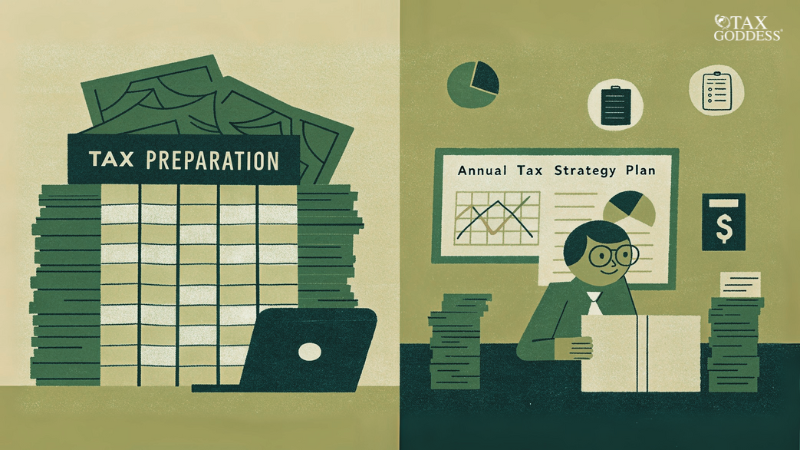Tax Preparation and Tax Strategy are often used interchangeably, but they’re far from the same. In fact, treating them as the same could be detrimental to your financial situation. One is about getting things done right when the clock’s ticking, while the other could mean the difference between losing a significant chunk of your income to taxes and paying far less. Intrigued? Stick around as we unpack why these two are not only different, but why understanding that difference could save your pocket.
What is the Meaning of Tax Strategy?
Now let’s zoom in on Tax Strategy (the secret sauce that’s often left out of the conversation).
Tax strategy is all about utilizing specific actions that can reduce your tax liability. It’s not just about being reactive when tax season comes around; it’s about taking action throughout the year to position yourself for optimal tax outcomes.
A great example of a tax strategy is contributing to a 401(k) or an IRA (both tax-advantaged accounts). These accounts allow you to defer taxes and potentially reduce your taxable income. Another example is structuring your investments to benefit from lower capital gains taxes.
It’s about making informed decisions at every step of your financial journey, from investments to retirement accounts to business ownership, to minimize your taxes legally.
What is the Meaning of Tax Preparation?
In contrast to tax strategy, Tax Preparation is the reactive step that comes after you’ve made all your decisions about income, deductions, and credits. Tax preparation is the process of filing your taxes, not planning for the future.
It involves gathering documents, completing tax forms, and submitting all the necessary information to the IRS. It’s necessary, but it’s really just the “completing the paperwork” part of the tax journey. You can’t save money on taxes with tax preparation alone.
The most important thing to understand about tax preparation is that it’s not the same as tax planning or tax strategy. Preparation is essential to stay compliant, but without strategy and planning, you might still end up overpaying.
What is the Difference Between Tax Planning and Tax Strategy?
While tax planning and tax strategy may sound similar, there’s a subtle but vital difference between them.
Tax Planning is the big-picture, proactive process of organizing your financial life to minimize your taxes over time. It’s about anticipating future taxes and structuring your finances to benefit from deductions, credits, and other tax-saving opportunities. Tax planning doesn’t happen overnight — it’s an ongoing process that requires tracking your income, expenditures, and investments.
Think of it as a blueprint. You’re mapping out your finances, assessing your current situation, and setting yourself up for future success. The key here is that tax planning isn’t just about saving money this year — it’s about laying the groundwork for long-term success.
On the other hand, Tax Strategy is the specific set of actions or tactics you take to achieve your tax planning goals. It’s more tactical, focused on what you do to lower your taxes. For example, deciding to contribute more to your 401(k), choosing to make an investment that offers tax-free growth, or opting for tax-loss harvesting in your investment portfolio are all part of your tax strategy.
The key takeaway: Tax planning is about creating a roadmap for your finances, while tax strategy is the action plan you use to make it happen.
What is the Difference Between Tax Preparation and Tax Planning?
Tax Preparation is the process of actually filing your taxes. It involves gathering all your financial documents (like W-2s, 1099s, receipts, and more), completing the necessary forms, and submitting them to the IRS by the deadline. This is the “getting things done” part of taxes — the time when you’re focused on reporting your income, deductions, and credits.
However, Tax Planning is before you even think about tax preparation. It’s what you do year-round to ensure your tax preparation process is smooth and efficient. Tax planning involves structuring your finances so you’re not blindsided by a large tax bill when it’s time to file.
The difference between the two is huge. Tax preparation happens at the end of the year when the damage is already done. Tax planning is about taking proactive steps throughout the year to minimize that damage and save yourself from paying more than you need to.
How Tax Strategy and Tax Preparation Work Together
So, where do tax strategy and tax preparation intersect? Ideally, they should work together seamlessly.
- Tax Strategy is how you lower your tax bill over the course of the year by making smart financial decisions.
- Tax Preparation is the process of making sure you’ve accounted for everything when it’s time to file your taxes.
Planning with a solid tax strategy can make the tax preparation process smoother and potentially reduce the amount you owe.
For example, suppose you’ve set up a tax-advantaged retirement account as part of your strategy. In that case, you’ll be able to report those contributions accurately during tax preparation, leading to a smaller tax liability when it’s time to file.
The Key to Reducing Your Taxes
To sum up, tax planning, tax strategy, and tax preparation all play key roles in your financial standing. But they each serve a unique purpose:
- Tax planning is the ongoing process of organizing your finances to minimize your tax bill.
- Tax strategy refers to the specific tactics used to implement a plan.
- Tax preparation is a necessary step in ensuring accurate reporting to the IRS.
Combining tax planning, tax strategy, and tax preparation can help ensure that you not only file your taxes correctly but also set yourself up for the future with minimal tax liabilities.
Claim Tax Savings with Strategic Tax Coaching (STC)
The STC clients at Tax Goddess pay an average of just 6.92% in taxes! If you’re tired of losing so much money during tax season, let’s talk about building a tax-saving strategy that works for YOU.








